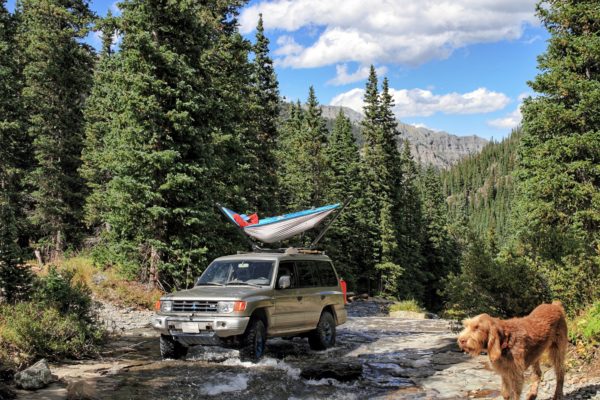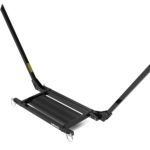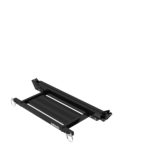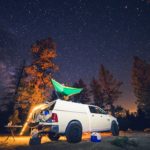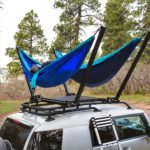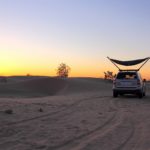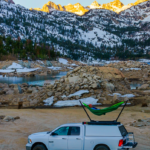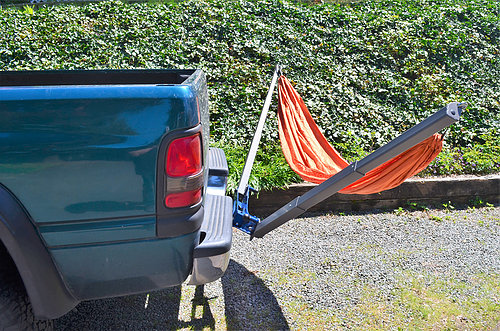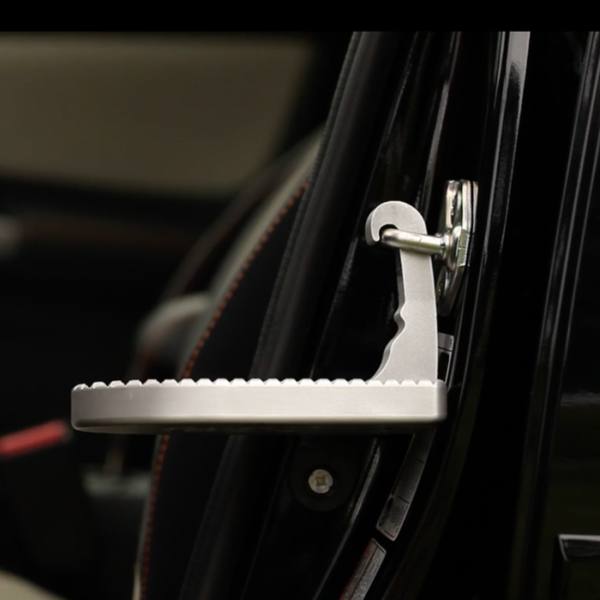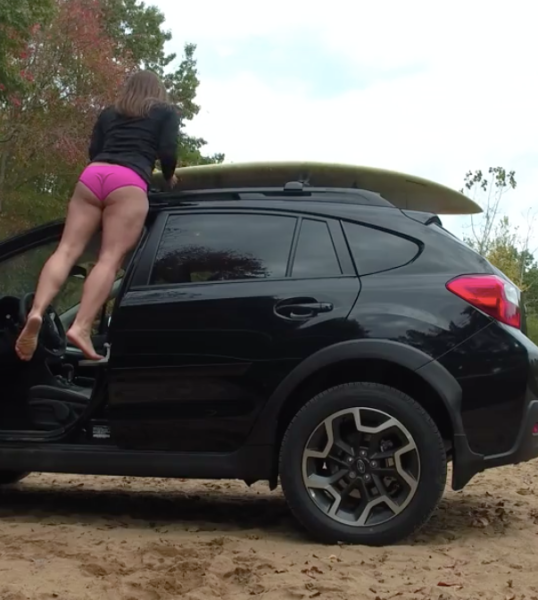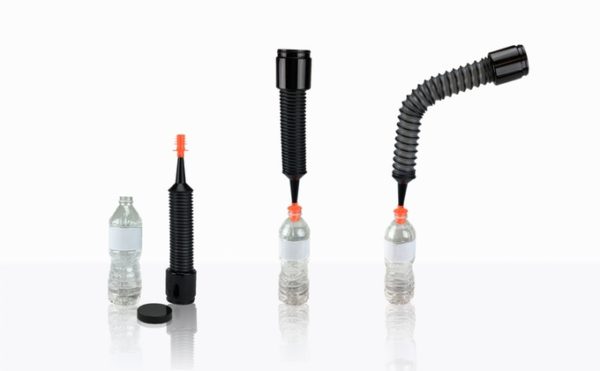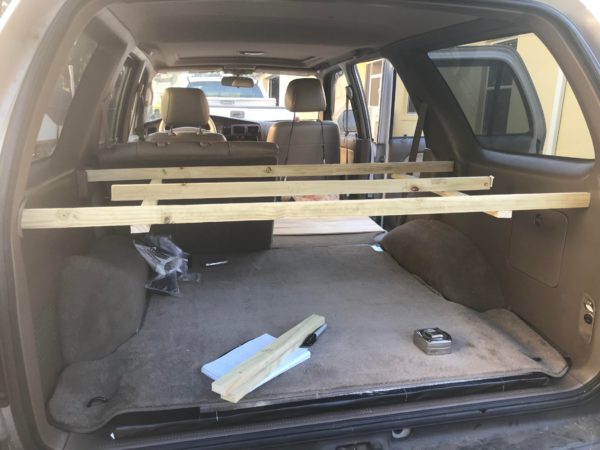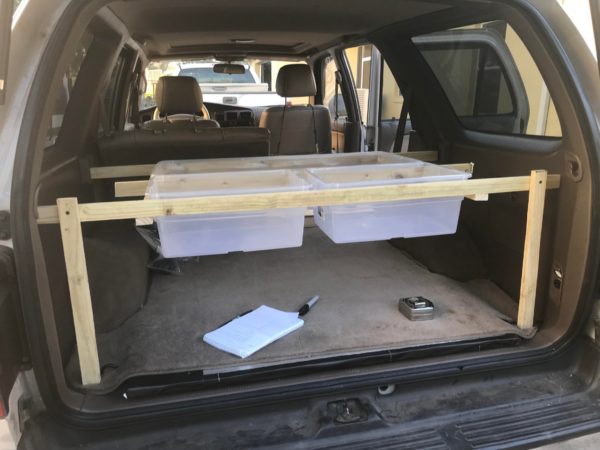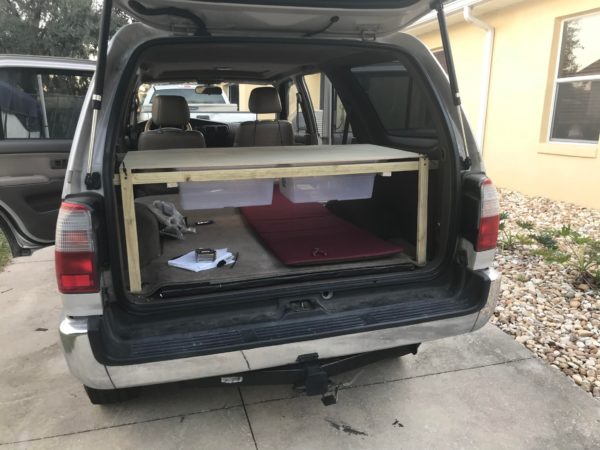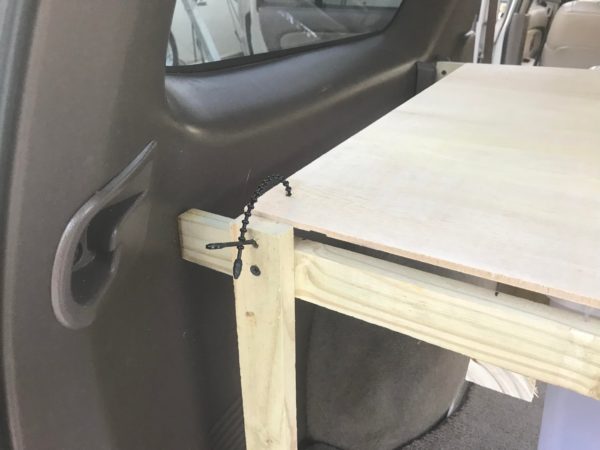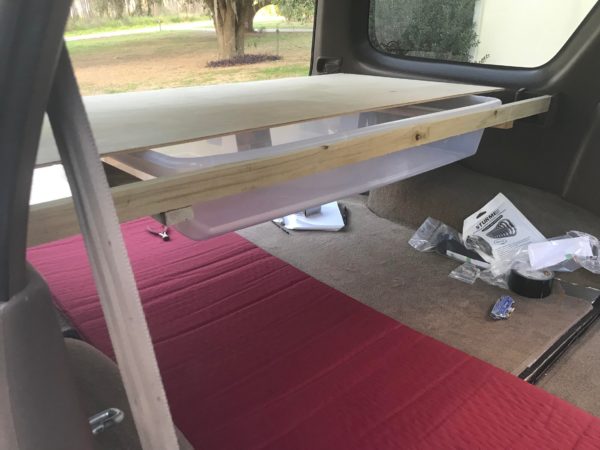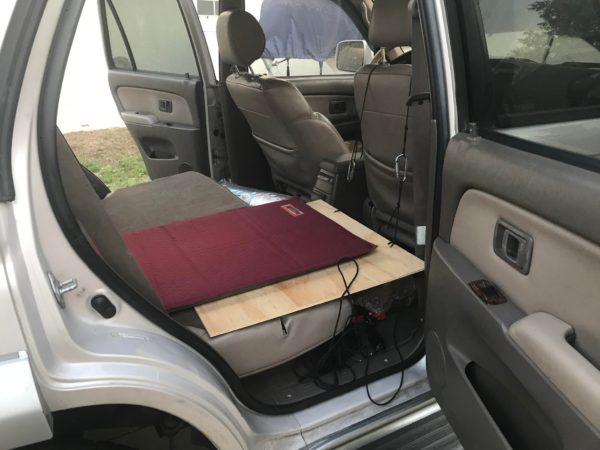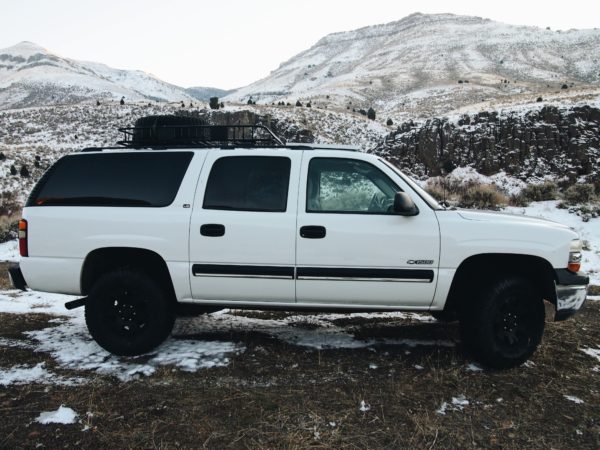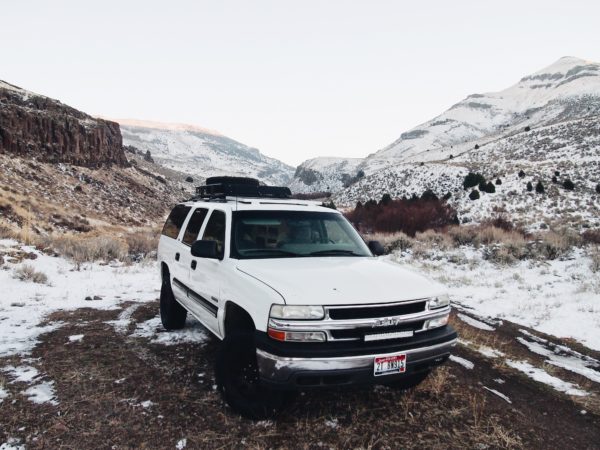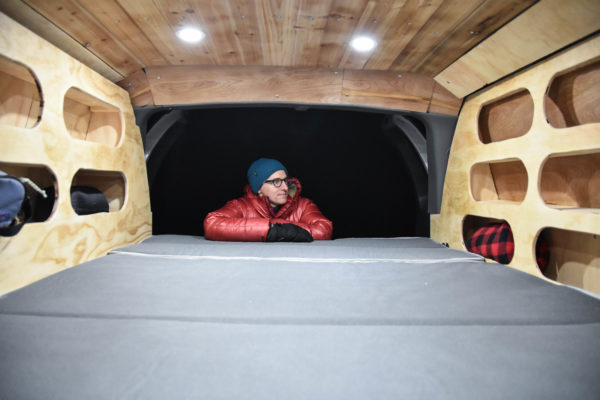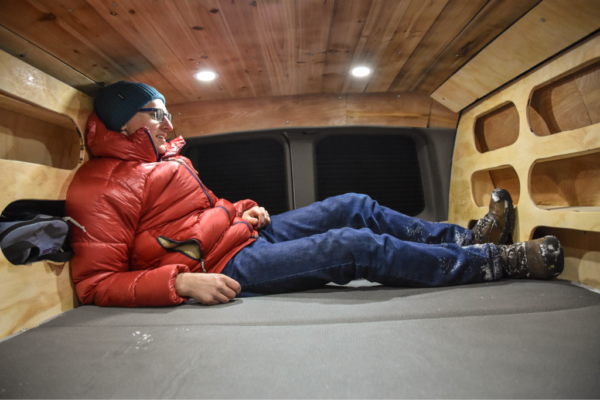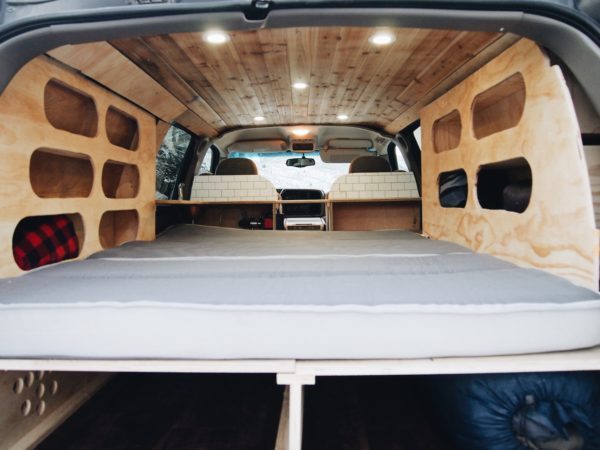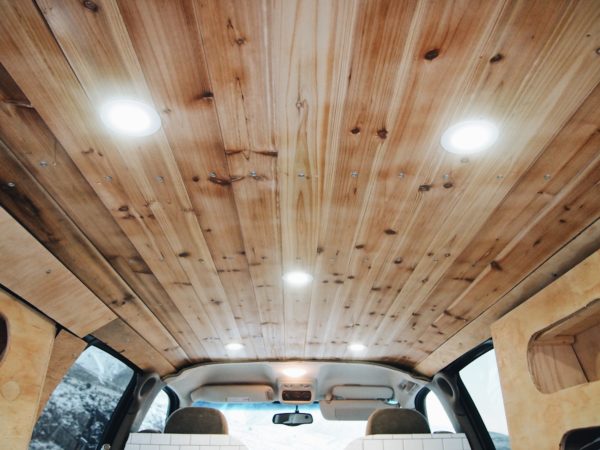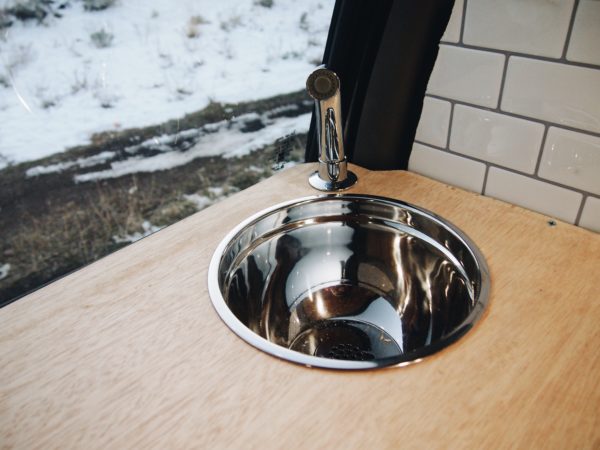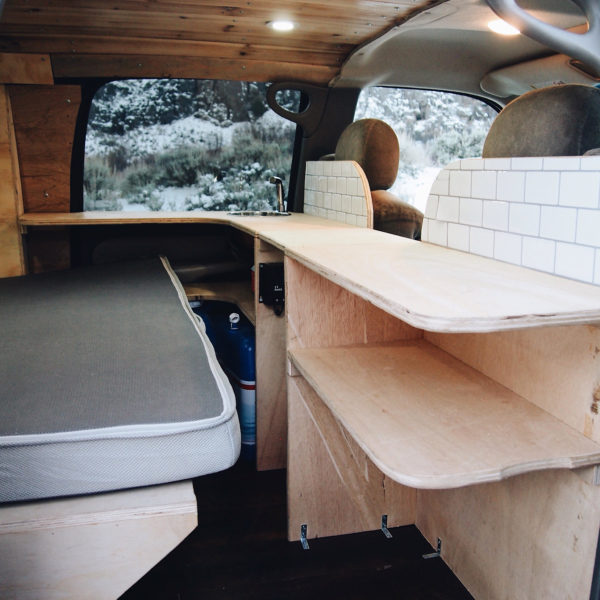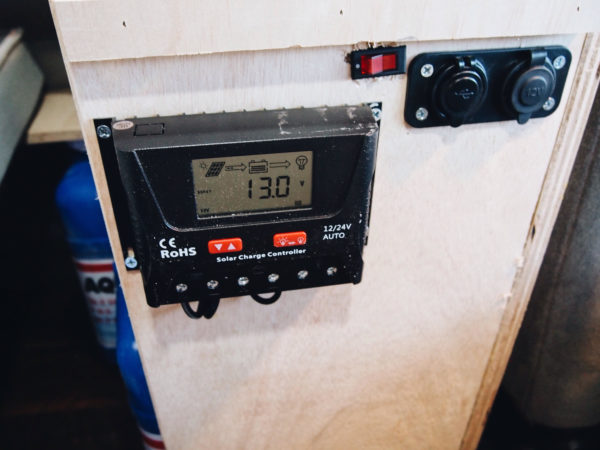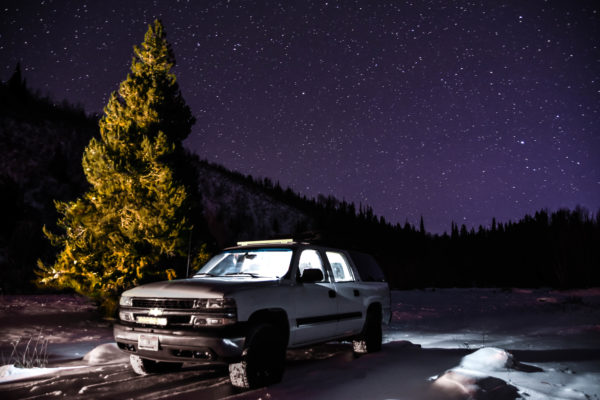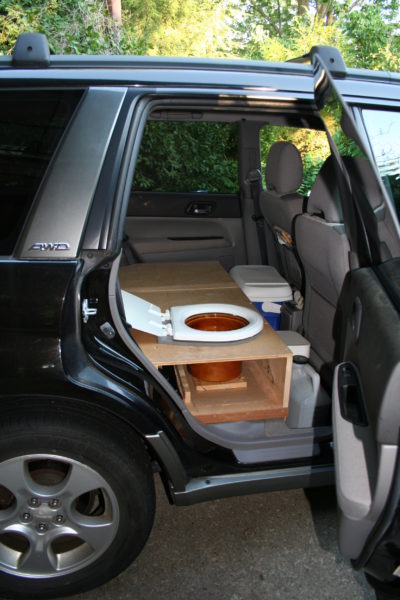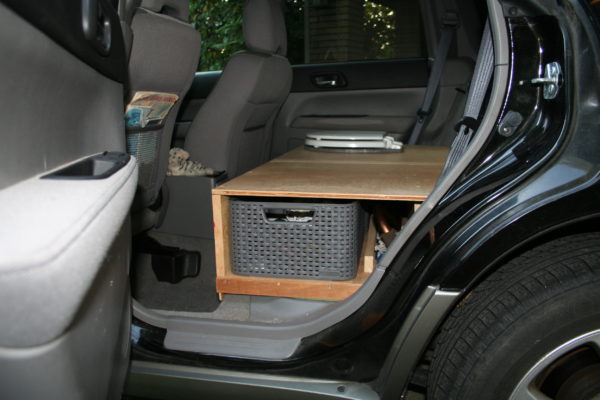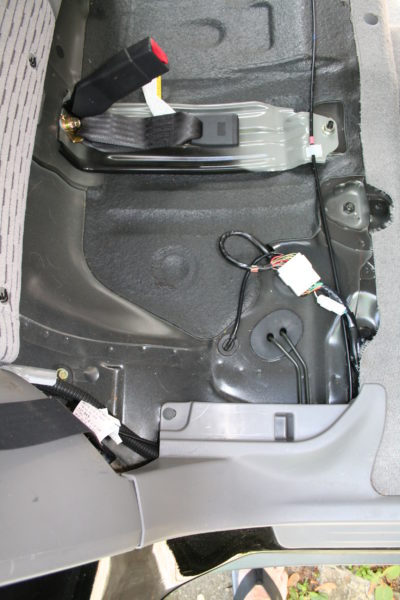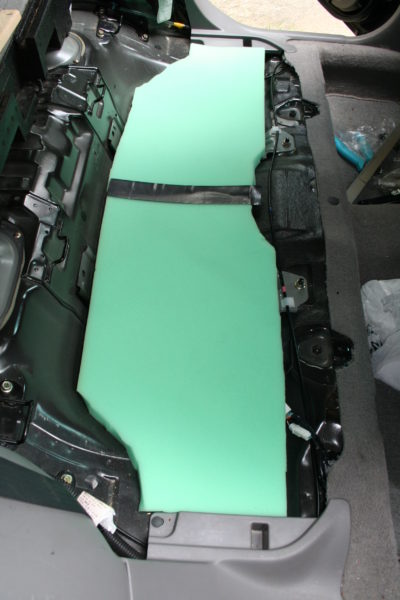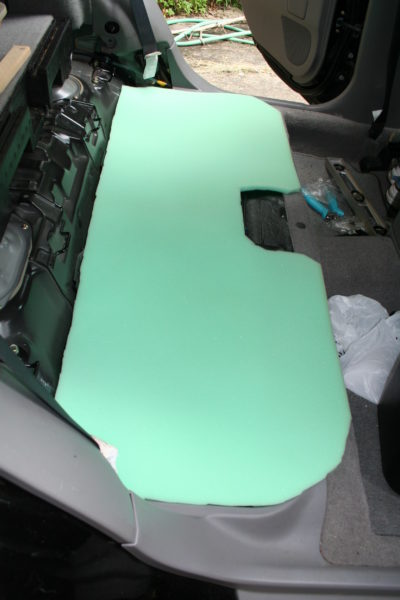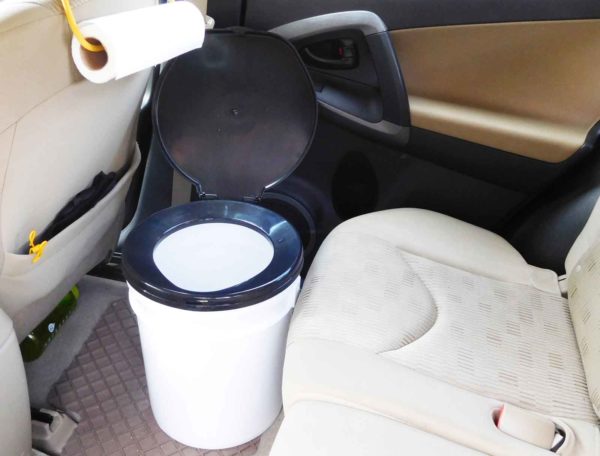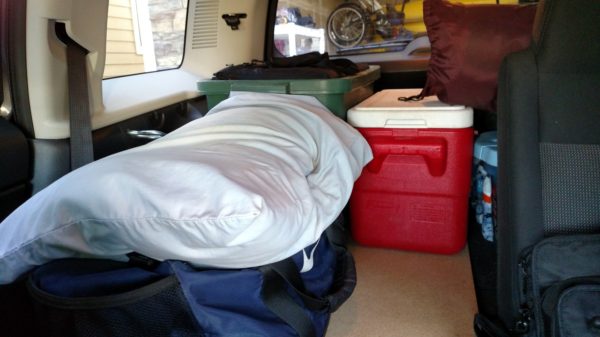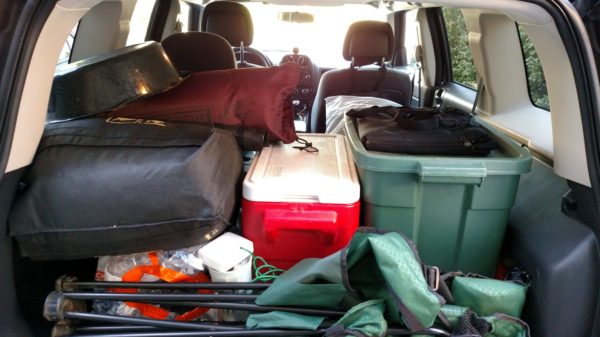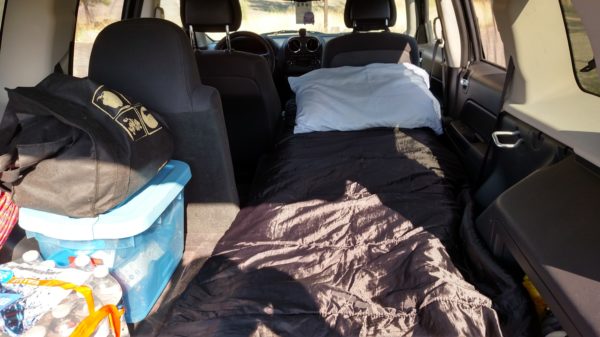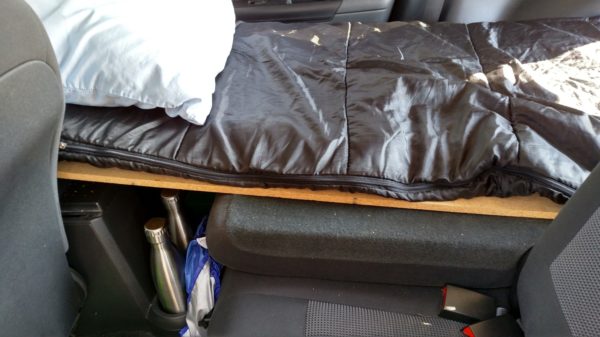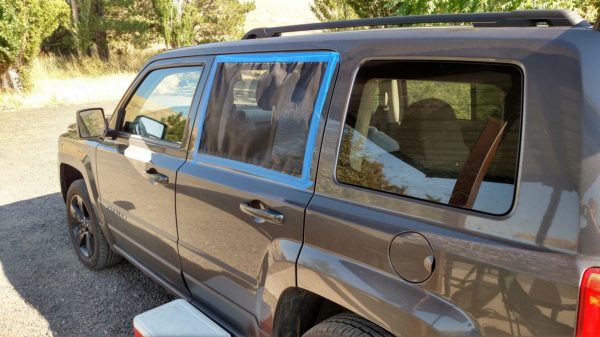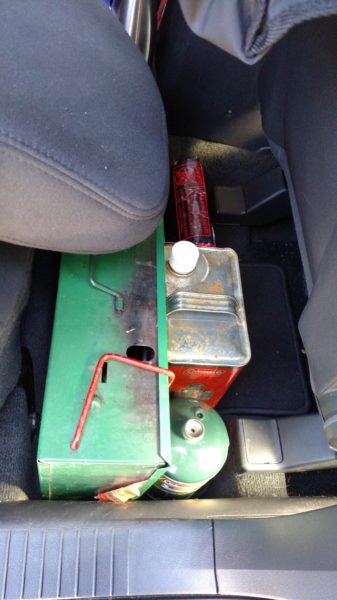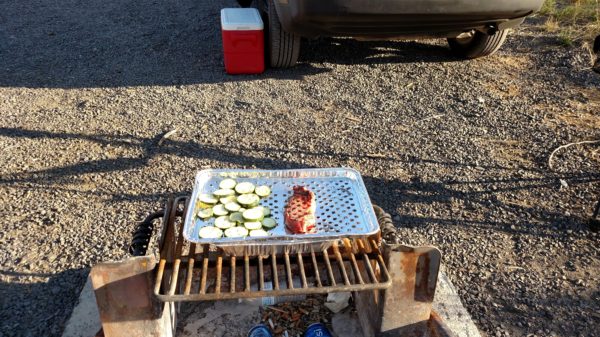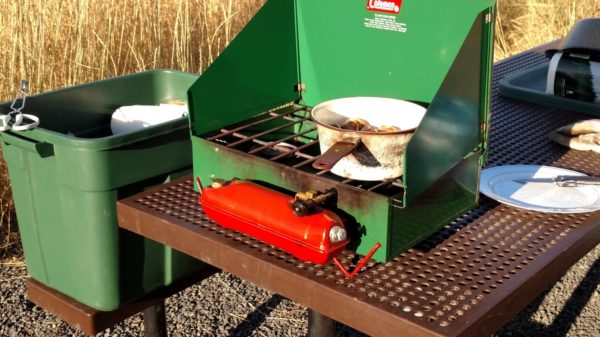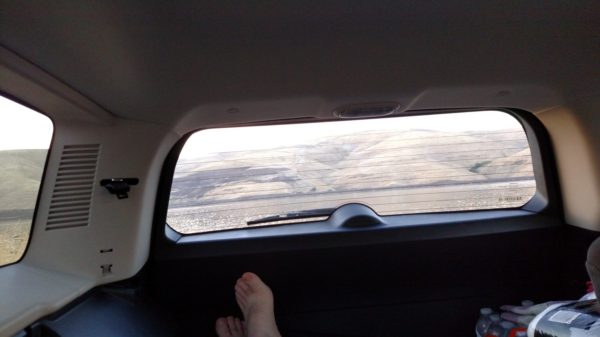Tristan’s note: This writeup and pictures are from Adam, an SUV RVing viewer who reached out to me wanting to share his rig, a 2013 Subaru Forester PZEV. His website is In Adam’s Shoes, and he blogs there about his travels. Head on over and subscribe if you want to follow his adventures. He’s also on Instagram (@adamtheplant).
***
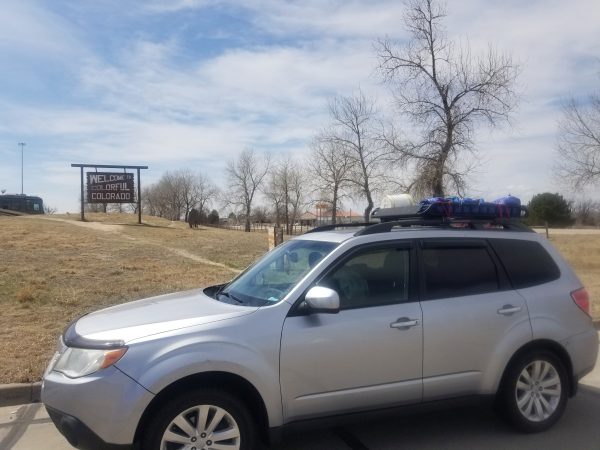
On the outside
Adding a cargo basket to my hitch was one of the best ideas I have ever had. That, and the addition of a storage box on the back. The storage box is not only weather/water resistant, which works great for storing the gear I don’t use as much as others (also the clothing that is out of season), but it also doubles as my kitchen counter! It provides me with enough space to have my dual burning stove, water jug, and cutting board all atop the box, and I still have the remaining cargo basket space for additional items if I go full chef-mode.
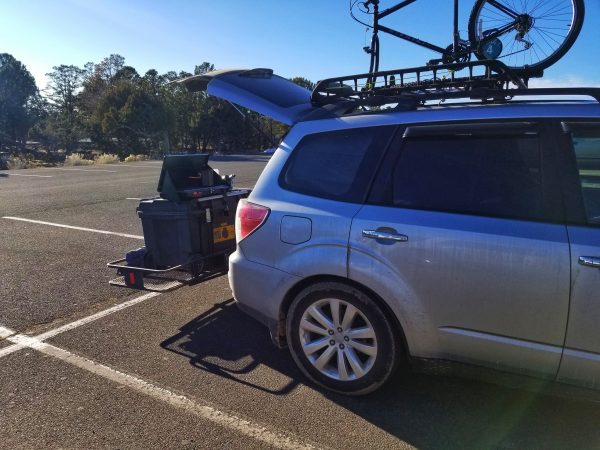
The cargo basket on my roof also used to be full of extra gear, but after noticing the drastic changes in MPGs, I decided to rearrange things and leave that space free. Now, my rooftop cargo basket holds my bike and bike tire when they are not in use, and since I have a panoramic sunroof in my vehicle, it is nice to be able to stand up through the sunroof and have a place to set things down (like my dinner plate), while I get a bird’s eye view of the sights before more (or at least I can see above the crowds that gather at specific places).
On the inside
Simple (but quite important) piece first. I made curtains that run the length of my back windows. For these, I simply cut an airline blanket (most of the time they are black, and work quite well as a blackout curtain) and sewed some “belt loops” to one side of the strips. Then, from the back of my vehicle where the utility loops are, I ran a bungee cord up to the front “oh-sh*t” handles. This allows the curtains to go up a couple inches past the front windows, blocking all viewing points from the outside-in (when I have my front window cover up as well).
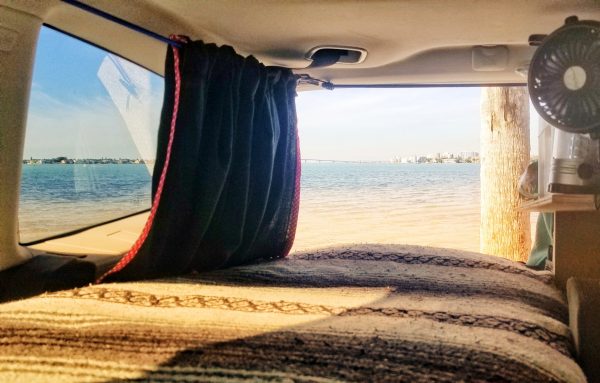
I decided to build a storage shelf for the inside of my car, but it was not very well designed to store a ton of things. The top part of my storage shelf works as my bookshelf, and has a drawer that really holds everything (the loose items). Doesn’t everyone, everywhere, have a junk drawer? And the bottom has a platform for my cooler to rest, and an old milk crate with another basket inside where I store my foods that don’t need a cooler, and my extra mason jars and containers. The entire shelf is lofted with 2x8s to give myself storage underneath it as well. This is where I keep my kitchen cleaning supplies, coffee, AeroPress, boiling pot, and some other random kitchen supplies (tea, seasonings, can openers, etc.).
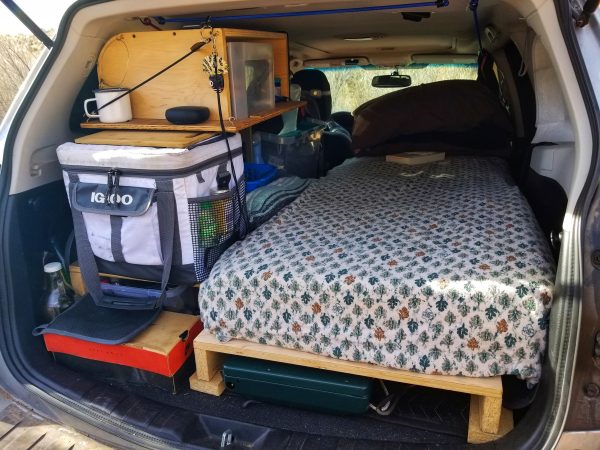
To the left (between the wall of the car and the storage shelf) is where I keep my propane bottles, plates, bowls, and extra kitchen supplies that isn’t regularly used (like my growler that was unfortunately empty for this photoshoot).
In front of this bigger container is where I keep my backpack that I use when in cities, or going into a café. It holds my electronics (cameras, laptop, chargers, etc.)
As you can see, in front (closer to the driver’s seat) of the storage shelf I have a couple big plastic bins as well. The top bin holds my clothes that I regularly wear (hiking pants, shorts, socks, briefs, shirts, etc.), while the bottom smaller bin holds the clothes that may be needed, but not on a regular basis (rain gear, jeans, bathing suit, gloves, hats, etc.).
As for the footwell located behind the driver’s seat, that is where I store my shoes. There is enough room for my city shoes, hiking boots, camp shoes, and flip flops.
Now for my bed. It was originally constructed to being lofted as high as the storage shelves I built (8 inches off the back seats). Turns out, this severely limited my head space when in bed. So, after a few months, I removed the 2x8s that ran the length of the bed, and replaced them with a couple blocks at the foot of my bed just to keep it even (the front of the bed rests on the back of the back seats (since Subaru back seats do not come out, or lay flat, I had to add the blocks to may the bed level). But thankfully, this unevenness actually created under-bed storage as well. Beneath my bed is a small folding table, my dual burner stove, cast irons, and bigger kitchen utensils (tongs, wooden spoons, spatulas, etc.).
Beneath the head of my bed, where the footwell is (behind the passenger’s seat) I have a medium sized utility gear box (holds ratchet straps, bungees, zip-ties, etc..) and on top of the gear box I have a 40L dry bag where my dirty laundry gets placed (since the drybag is air-tight, it also keep the smell and dirt contained), and some small boxes of detergent.
Inside both back side doors I have a no-see-um screen cover for my back windows, so I can sleep with my windows cracked, or open and not have to worry about insects.
I also somehow managed to get my longboard to fit across both footwells of the back seats but still leave enough room for the other items.
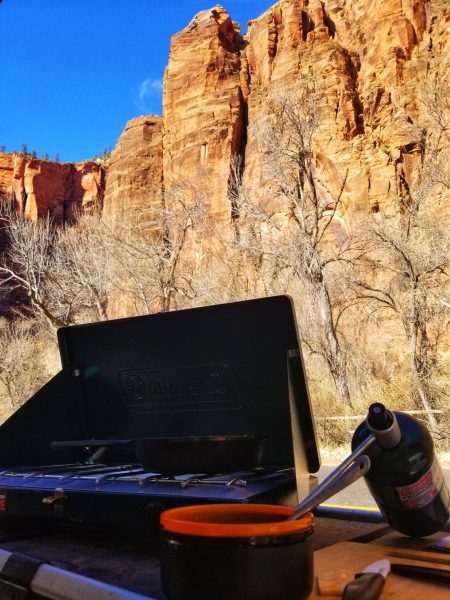
And finally, the front seat. In the shotgun seat I have a plastic box that holds my regular-use water bottles, travel and regular mug, sunglass cases, portable power packs, headphones, etc.. And in the footwell of the shotgun seat I have a small plastic container that holds extra electronics (power converter, wall adapter, camera mounts, etc.). On top of this smaller box is where I keep my bike seat (no one likes a wet butt, so I keep it out of the weather), microfiber rags (to wipe the windshield of humidity buildup), and it is also where I keep my window blinds for the front windows and windshield.
What I like about the vehicle
Being that it is an all-wheel drive Subaru, I have yet to have troubles going through even some of the toughest of terrains. Now obviously, I am not able to do any rock-hopping or anything along those lines, but my car (otherwise known as Sugar), has gotten me through feet of snow, ice, rivers, mud, you name it. I truly believe when it comes to beating Subaru off-road ability, it cannot be matched. The only modifications I have added to Sugar are all-terrain tires, and wind/rain guard you see on the hood and each of the 4 windows. Aside from that, this make has been a superb choice because of the panoramic sunroof that came with it; When laying in my bed, I am able to look out of my roof and see the star-scape above, or even just have some natural lighting if I choose to spend the day in bed. Also, Sugar is a smaller vehicle (as far as living out of, or overlanding goes), but that is a big bonus when looking at MPGs. I average 24MPG, with all my gear loaded up, and myself inside!
What I dislike about the vehicle
This is hard to write. Obviously the space is tight. Something with a bit more room would be fantastic so my external storages could be removed (reducing the tail-drag caused by the weight hanging off the back of my vehicle), or put to use for other items. I know that a larger vehicle comes with its own flaws (less MPGs for example), but the idea of having more space to move around sounds magical.
After deciding to convert to full-time travel, I knew I would have to make some big adjustments to my rig and how I took it overlanding.
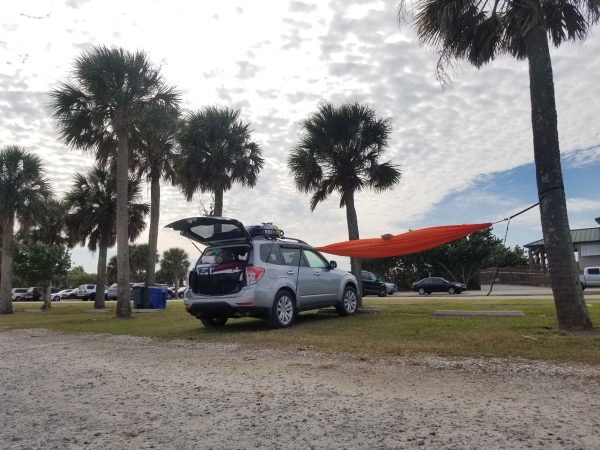
What I’d change
Over the last 15 months, I have made some significant changes to the setup of my interior. The biggest being lowering my bed to allow for more headspace. But for now, the only thing I have been bouncing around inside my head is the possibility of a small off-road trailer to pull along with me, instead of the cargo basket I currently have. Again, I know that a trailer adds its own share of complications (extended vehicle when looking for parking, eliminates stealthiness, etc), but more room is sometimes worth the added stresses.
Thanks again to Adam for sharing his rig with us, and again, check him out on his website and on Instagram.
